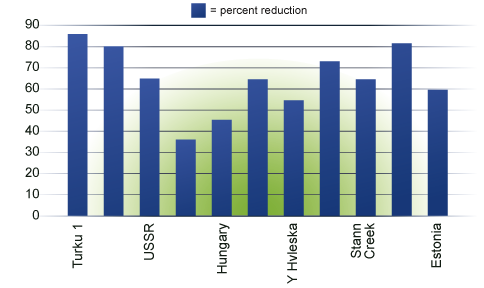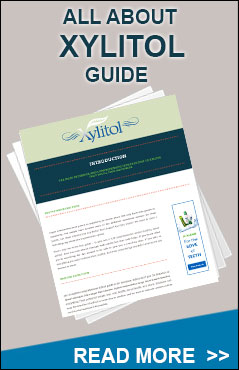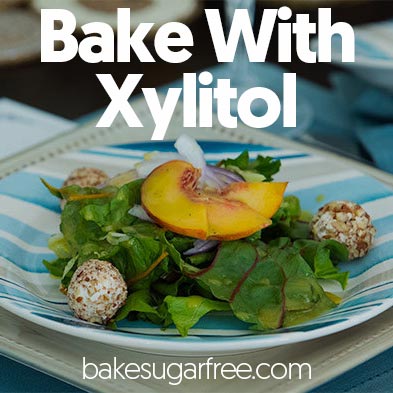Professional Dental Info About Xylitol
Daily use has shown remarkable xylitol dental benefits. Xylitol’s noncariogenic five-carbon structure keeps it from being metabolized by bacteria, stopping the production of tooth-decay causing acid. By using 100% xylitol products throughout the day, bacteria is prevented from creating the acids that damage the teeth. Regular use of Xylitol products prevent plaque from gaining hold on dental surfaces. Hence, it protects the mouth between brushing and flossing for both adults and children.
Xylitol’s dental benefits also include a decrease of bacteria. Xylitol enhances the remineralization of teeth, particularly in small decay spots just developing in the tooth enamel. Bacteria are unable to produce acid in the presence of xylitol and as a result the plaque pH does not decrease. The stable pH prevents demineralization, and hardens the lining of the cavities making untreated cavities less sensitive. This was clearly demonstrated in the study done in Belize on school children. In a 1980’s double blind study, 1,277 school children chewed gum several times a day. Some were given ordinary gum sweetened with sucrose; others were given gum sweetened with sorbitol or xylitol. After 40 months of gum chewing (including weekends, holidays, and vacations) the xylitol group experience 73% fewer caries, sorbitol group a reduction of 26%, and an increase of 120% of caries in the sucrose group. Xylitol’s naturally cooling and sweet tastes also increase salivary flow, which optimizes the pH level in the mouth further promoting dental health. Research has confirmed and expanded on earlier findings.
Caries prevention: Xylitol Dental Benefits vs. Control

(S. mutans), is known to increase acid in the mouth, as they produce an acidic environment, additional acid-loving microorganisms have a selective survival advantage and exponentially will cause more damage. However, if the acid in dental plaque is kept low, then demineralization is slowed or halted. Since xylitol slows demineralization and enables some rebuilding of the enamel, it assists in the prevention of new cavities from forming and over time can reverse tooth decay that already occurred. Studies have shown that using xylitol five times per day is very effective at preventing caries.
Patient Engagement Tips
When talking to your patients about xylitol dental benefits there are a few rules of thumb that you want to follow. First, quantity is not as important as frequency. Second, since you know they need 4-5 exposures a day, recommend 6-7. Third, be brand specific.
Quantity vs. Frequency
1) The number of exposures is much more important than the quantity of xylitol. As long as the product is 100% sweetened with xylitol you are more than likely getting enough xylitol. All that needs to happen is we need to replace the carbohydrates and sugars that are in the mouth with xylitol. This can be done by using candies that you suck on, gum that you chew for more than 2-3 minutes, toothpaste and mouthwash with xylitol, candies with xylitol, etc. Anything that helps to stimulate saliva and helps wash out sugar residues form whatever we just ate and replace those residues with xylitol. We sometimes hear people say or read in articles that 7-10 grams a day is what we need, according to newest research it isn’t the quantity that matters as much as the frequency. STRIVE FOR FIVE.
Exposure Frequency
2) We all know that patient compliance is key in any healthcare program. Since xylitol is such a great tasting solution it is one that can be easily followed. We know your patients need 4-5 exposures a day, so if you want them to get 4-5 exposures then start by telling them 6-7 exposures. Another thing that could be helpful in getting compliance is to have them swap out products they currently use with products that contain xylitol. Have them swap out their current toothpaste and mouthwash for toothpaste and mouthwash with xylitol. Have them use xylitol. Have them use xylitol to sweeten their tea and coffee. Xylitol breathmints and gum, there is such a wide variety of products available that it is quite easy to get to the recommended 5 exposures a day. STRIVE FOR FIVE for the best xylitol dental benefits.
Be Brand Specific
3) Finally be brand specific when talking about xylitol to your patients. The reason for this is not so you are pushing a single brand, but because if you talk about xylitol in general terms then your patients will simply go buy the first thing they see that says xylitol on its packaging and changes are that this product will not have enough xylitol to have any positive effect. Pick a brand that you know is 100% xylitol and is available where you live. You may also want to take into account the number of different products in their product line. The wider variety of products then the easier it is to get the needed exposures.
When recommending xylitol products to your patients, be sure that you are recommending products that are 100% xylitol. You want to make sure that there is no mannitol, maltitol, sorbitol, or HSH (blended polyols) as they cavity causing bacteria thrive on these sweeteners. There are also a number of companies out there touting their products as containing xylitol and being tooth friendly while the main sweetener is labeled as HSH followed by low levels of xylitol and significant levels of acid. Any dental candies that are labeled “sours” you can assume are going to have high levels of acid. Check the ingredients, not just the front label claims before recommending them to your patients. The products we list on the products page of this website will have more information.
Xylitol Dental Benefits: Benefits in the Evidence
The evidence of xylitol’s dental benefits are difficult to dismiss or take lightly. With its sweetness, low glycemic index, and multifaceted benefits continue to make xylitol more appealing. Since patient compliance has an extensive impact on costs and strategies for dental care, all dentists should find something to smile about when it comes to xylitol dental benefits. Xylitol is widely available in health food stores in a variety of forms such as candy, toothpaste, mouthwash, floss, gums, mints, and as a bulk sweetener.





